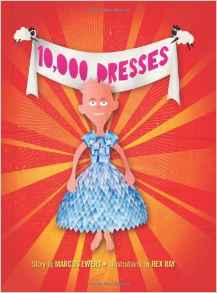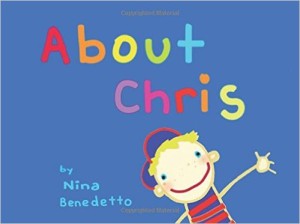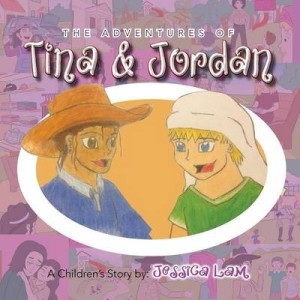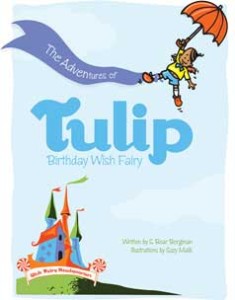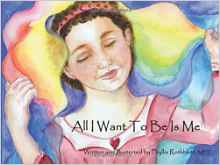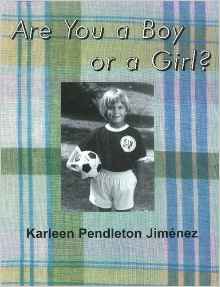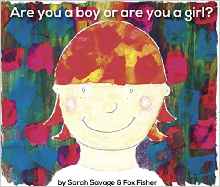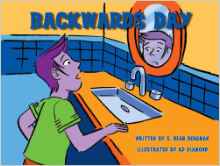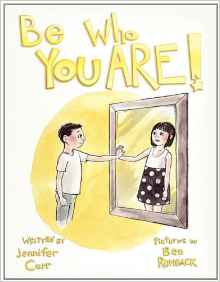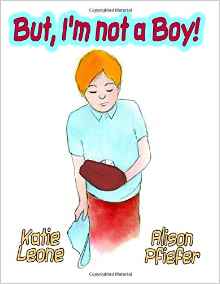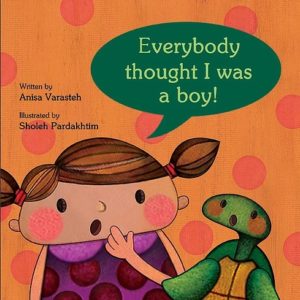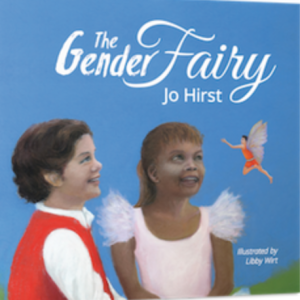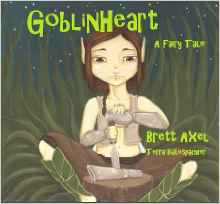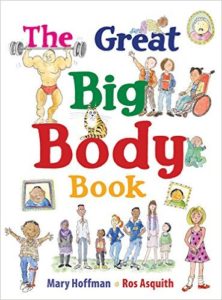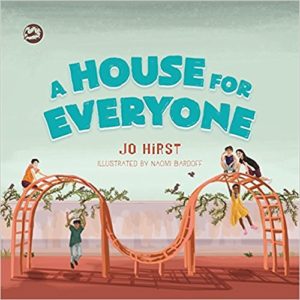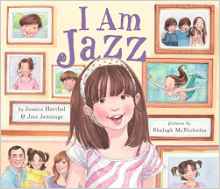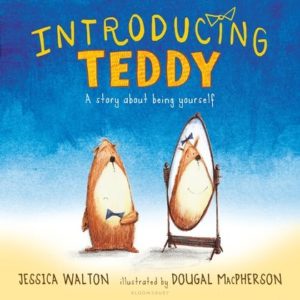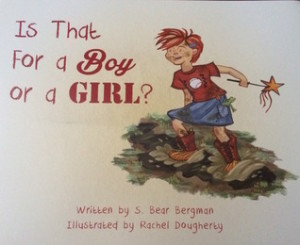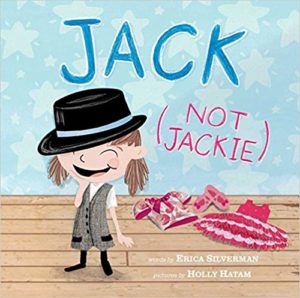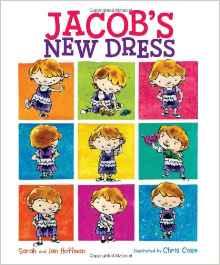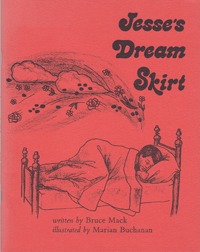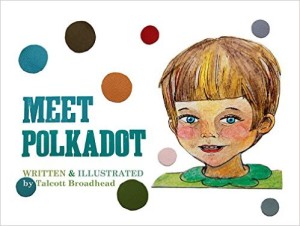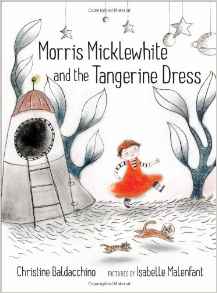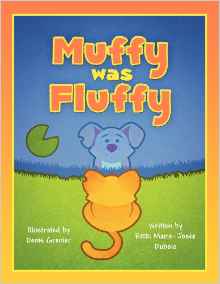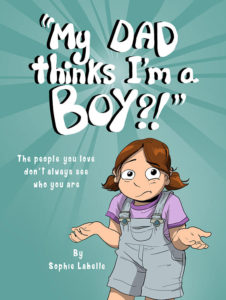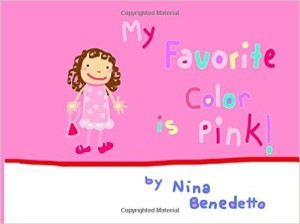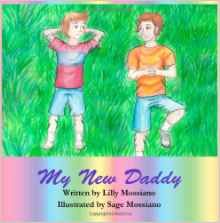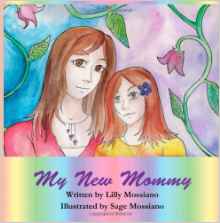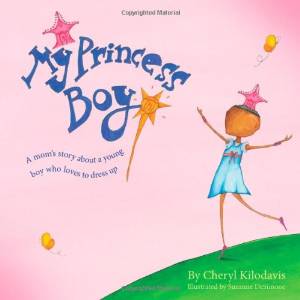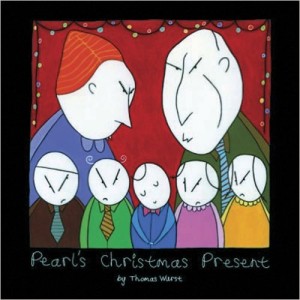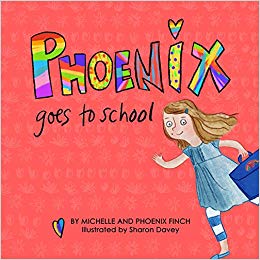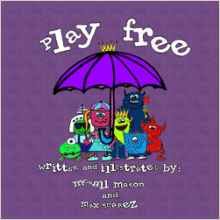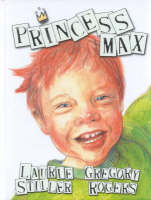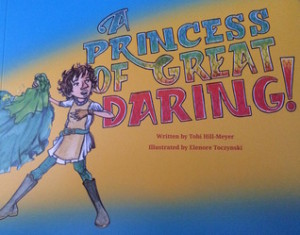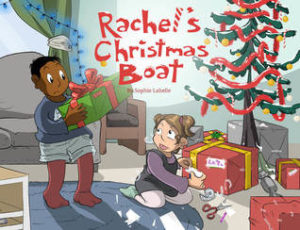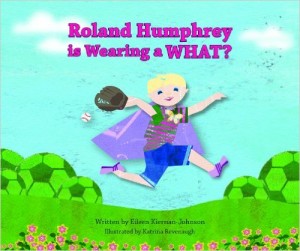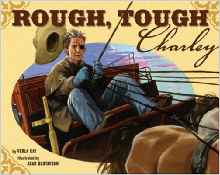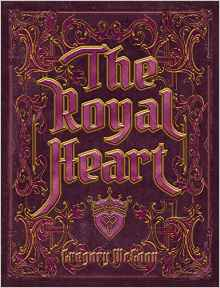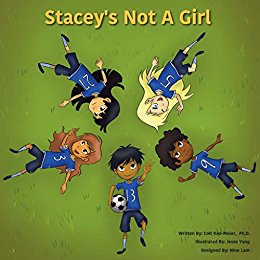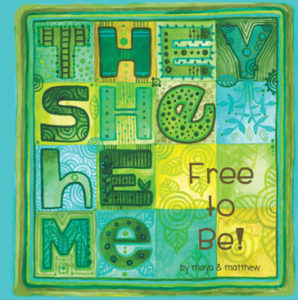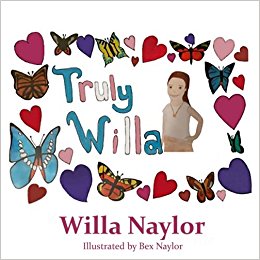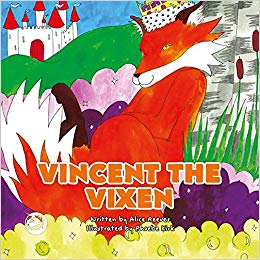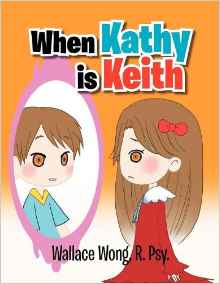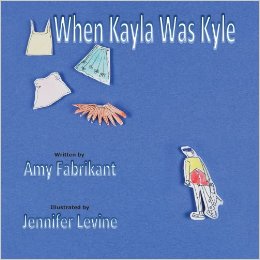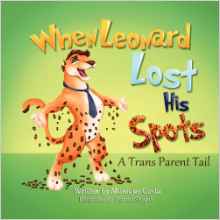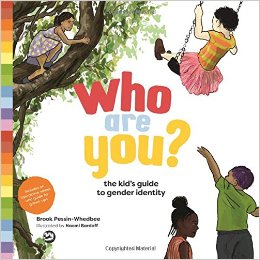Picture books with trans and gender diverse characters
This page offers a brief summary and review of picture books with trans and gender diverse characters. Please note that character pronouns and names are used as they appear in the books.
Marcus Ewert & Rex Ray, 2008, Seven Stories Press
Bailey has dreams about imaginative different dresses which she wears, and wants a dress for herself. Her family don’t understand, telling her that boys don’t wear dresses. She sees an older girl making dresses and together they make mirror dresses and wear them.
This award-winning book has engaging illustrations which are bright and bold, and the story is told from Bailey’s point of view as she attempts to assert her gender identity. This book refers to Bailey using (preferred) female pronouns throughout, with her only family referring to her as a ‘boy’. While this affirms Bailey’s gender identity, it may be confusing for children, particularly as Bailey never explicitly says she’s a ‘girl’, only that she doesn’t feel like a boy. Bailey’s family are depicted in gender stereotyped locations/activities.
Themes: transgender, trans girl, clothing
Nina Benedetto, 2015, CreateSpace
This book is written from the perspective of a teacher, who tells the ‘true story’ of Chris. Chris is presented as a stereotypical boy – who loves playing with trucks, drawing super heroes, using facepaint to draw scars, and playing a pirate for Halloween. When asked who that ‘great little boy’ was, the teacher would answer by saying ‘that’s Christina’, much to the dismay of Chris. Chris explains he is a girl from his belly button down but a boy from his belly button up and his teacher tells him she understands and believes him.
This is a very simply story, showing how a teacher comes to understand that Chris is a boy. The use of the words ‘true story’ may help readers/listeners to support the ideas presented. As with so many books, gender stereotypes are heavily drawn on.
Themes: transgender, trans boy, teacher
The Adventures of Tina & Jordan
Jessica Lam, 2013, Xlibris LLC
Tina does not like to act like a ‘girl’ or do ‘girl things’ like her family taught her. She tries on her Daddy’s cowboy hat, hiding her hair under it so she looks like a boy. She goes to the park and stops some boys on the playground from teasing another boy (Jordan) who is wearing a pink towel on his head to approximate long hair and holding a doll. Tina and Jordan are accepting of each others’ gender preferences and become friends. Jordan’s mum helps Tina’s mum to be accepting, and Tina’s mum tells Tina she loves her how she is.
This book focuses on friendship between two gender non-conforming children. It also includes mother support and acceptance. However, the language of approximation is used (e.g. ‘like a boy’, ‘really a girl’, ‘pretend I’m a boy’) and it is unclear what the message of the book is. Furthermore, there is a strong focus on naming gender-typed activities (e.g. climbing trees) in order to cross the binary.
Themes: gender diversity, gender non-conformity, friendship, mother support, teasing
The Adventures of Tulip The Birthday Wish Fairy
S. Bear Bergman & Suzy Malik, 2012, Flamingo Rampant
Tulip receives birthday wishes from children who have turned 9 all over the US and Canada. One day, Tulip receives a wish from David ‘to be a girl named Daniela’. He doesn’t know what to do so he consults the entry ‘Gender Change’ in the Wish Fairy Rule Book which tells him to see the Wish Fairy Captain. The Wish Fairy Captain explains Daniela’s wish to Tulip and tells him how to make her wish come true. Tulip continues to grant wishes to help Daniela and becomes the special Gender Wish fairy.
This book affirms Daniela’s gender identity, with the Wish Fairy Captain explaining to Tulip that they have to ‘help’ her. However, this explanation draws on gender as a natural binary where there are only boys and girls, who are paired opposites, and the Wish Fairy Captain is positioned as an expert. There is little attention to Daniela herself in the book. She’s depicted as receiving gender stereotyped items, with her ‘boys’ ice skates’ replaced by ‘pretty figure skates’. This book is lengthy, with some sentences which don’t seem pertinent to the storyline.
Themes: transgender, trans girl, wish fairy, imaginative
Phyllis Rothblatt, 2011, CreateSpace
This book tells the story of multiple children who are transgender or gender diverse through rhyming and repeated messages. Some characters are transgender, others have non-binary genders. All characters are asking to be allowed to be themselves.
This book celebrates gender diversity, including the possibility to identify as having a non-binary gender. This is done via the inclusion of multiple characters which may be potentially confusing for children.
Themes: transgender, gender diversity, non-binary genders, multiple characters, celebratory
Karleen Pendleton Jiménez, 2000, Green Dragon Press
This book loosely tells the story of the author’s life as a girl who liked to engage in a range of activities, and had short hair. It focuses on other people not understanding that girls do not have to like ‘girl things’, and other children asking ‘Are you a boy or a girl?’ because of things such as her short hair cut and interest in particular toys. Each time she is asked this, the girl answers back ‘I’m a girl’, more assertively each time. She is sad she’s asked this because she likes doing things without thinking about acting like a girl or a boy. Her mama supports her and says while others may not understand, knowing you can do anything is the best way to live.
This book has a strong argument that there should not be ‘girl things’ or boy things’, just things that any child can do. However, to make this argument, the book draws on ideas of ‘girl things’ and ‘boy things’, and the author is the only child to break out of these, although her mama asserts that there have always been ‘girls who like to do boy things and boys who like to do girl things’. Each child who asks ‘Are you a boy or a girl?’ is mentioned using a gender-typed description (e.g. ‘Dionne in the dangly earrings’). The story is accompanied by black and white photos and sketches which may not engage children.
Themes: gender non-conformity, emotions, mother support
Are You A Boy or Are You A Girl?
Sarah Savage & Fox Fisher, 2015, TQUAL Books (second edition published in 2017 by Jessica Kingsley Publishers)
Tiny has moved to a new town and is about to start at a new school. Tiny tells the reader about liking lots of different toys, activities, and clothes which are not limited by gender stereotypes. When Tiny goes to school, a boy called Buster picks on Tiny several times about Tiny’s name and whether Tiny is a girl or a boy, and is reprimanded by the teacher. Tiny is asked several times throughout the book ‘are a boy or a girl?’, but doesn’t answer until the last page when Tiny says ‘I am me!’.
This story shows a child who is interested in a variety of pursuits and is not restricted by gender expectations. However, most of the supporting characters are shown in gender-stereotyped activities and clothing.
Themes: non-binary gender, gender diversity
S. Bear Bergman & K.D. Diamond, 2012, Flamingo Rampant
Backwards Day occurs on the planet Tenalp once a year. On this day everything is backwards, including gender, where girls become boys and vice versa. Andrea loves Backwards Day because she wants to be a boy every day. One Backwards Day, Andrea woke up and found she was still a girl and was very sad to miss her favourite day. However, the next day she woke up to find she was a boy, which also happened the day after. Andrea told her mum to call her ‘Andy’. Andy’s mum and dad took him to see a ‘Backwardsologist’ who explains that being a girl was actually backwards for Andy. Andy is much happier than he was previously.
This book is creatively imagined, set on a (very earth-like) planet, where all of the characters are different colours. It is one of the few books to depict a trans boy. However, it largely draws on stereotyped clothing and interests and the idea that boys and girls are fundamentally different, although attempts at times to critique this. The ‘Backwardsologist’ is positioned as an expert needed to affirm Andy’s gender identity, and Andy’s parents do not seem to understand his affirmed gender. The book is slightly long and is written in a font which may make it difficult to read aloud.
Themes: transgender, trans boy, imaginative
Jennifer Carr & Ben Rumback, 2010, AuthorHouse
Nick has always felt like a girl. His parents support him but Nick still presents as a boy in public, including at school. Nick visits Dr Bee who supports the family for Nick to transition to live as her affirmed gender identity, with her chosen name Hope. Her younger brother Will doesn’t understand at first and is unsure how this will impact their sibling relationship. He is reassured by Hope who tells him that she is still the same person. Some people don’t understand but her family love her and Hope is happy.
This book addresses a range of issues (school, sibling relationship) and Hope’s parents are supportive throughout. However, clinical language is used (e.g. ‘girl brain’, ‘wrong body’) and there is a focus on health professional intervention. Hope’s pronoun and name change occur only after having visited a health professional for a second time. There is also a focus on being able to have long hair and wear dresses, and many characters are shown in gender-typed clothes.
Themes: transgender, trans girl, doctor, parents supportive, sibling relationship, clothing
Katie Leone & Alison Pfeifer, 2014, CreateSpace
Sarah was sad because nobody knew she was a girl and everybody thought she was a boy. Her parents called her David but she felt like Sarah. She didn’t want to engage in activities she did like playing ball, war, or wrestling or building a treehouse but would rather play dress ups and dolls and bake. Sarah’s parents knew she was sad and asked him why this was the case. Sarah tells them she is not a boy but is a girl, called Sarah. Her parents are shocked/surprised and had not heard of something like this before but support her as their daughter.
This book uses Sarah’s preferred pronoun and name throughout. However it features heavily gender-typed activities and clothes (sports, war, wrestling, cowboys, dress ups, dolls, baking) and minor characters all engage in gender-typed activities.
Themes: transgender, trans girl, parents supportive, friendship
Everybody thought I was a boy!
Anisa Varasteh & Sholeh Pardakhtim, 2018.
Jo Hirst & Libby Wirt, 2015, Oban Road Publishing
A beautiful, simple, story about a gender fairy, who affirms to two children that they can be who they are, rather than who they are expected to be on the basis of their assigned sex. Written in simple, clear, language, the story avoids the problems associated with changing pronouns or gender stereotyped behaviours or clothing evident in other books. Instead, the book does an excellent job of emphasising that sex is an assignation that does not determine gender; that what matters is how children experience their gender (as opposed to their assigned sex); and that children have the right to acceptance. Importantly, the book goes even further by finishing with a question about whether it matters if the fairy themselves is a boy or a girl. Overall, this book does an excellent job of challenging assumptions about how we talk and think about gender in ways that will be understandable to young readers.
Themes: transgender, gendered expectations, affirmation
Brett Axel & Terra Bidlespacher, 2012, East Waterfront Press
Julep will soon be coming of age and the elders have said Julep will grow up to be a fairy, despite wanting to be a goblin. Julep grows wings but joins the new goblins rather than the new fairies. The elders allow Julep to stay with the goblins for the day, presuming Julep will be happy to be with the fairies the following day. Julep makes a vest to hold down wings and gauntlets with stone claws and continues with the other goblins. They meet another tribe, who see Julep’s wings. Julep tells them about being a goblin on the inside. Julep supports a member of the other tribe, Tuck, who will become a goblin while feeling like a fairy.
This book manages to avoid the use of gender pronouns, although it seems that fairies appear to be female and goblins male. Species change may not necessarily be understood as a metaphor for transgender.
Themes: species change, no gender pronouns
Mary Hoffman & Ros Asquith, 2016, Frances Lincoln Children’s Books
Jo Hirst & Naomi Bardoff, 2018, Jessica Kingsley Publishers
This book focuses on the friendship amongst a group of gender diverse children. The children are working together to build a house made of branches to play in together. Each character is introduced to the reader, including their name, gender, pronouns, and things they like to do.
This is one of the few books to explore gender diversity beyond binaries and is affirming of all of the characters’ genders using carefully chosen words to describe them. The book celebrates gender diversity and friendship. Rather than being a story-driven book, it focuses on telling the reader that children can be diverse in their genders and explains what this might look like. While this could appear simplistic for older readers, it will be useful for discussing gender diversity with all children, and for gender diverse children to recognise themselves amongst the characters.
Themes: gender diversity, non-binary genders, friendship, multiple characters, affirmation
Jessica Herthel, Jazz Jennings & Shelagh McNicholas, 2014, Penguin
Jazz tells the story of her life so far, telling the reader about her favourite things to do and her family. Jazz explains that she is not like her best friends because she is transgender. She says that her family were initially confused but were then very supportive, and received lots of help from a doctor. Jazz encounters difficulties at school in terms of being expected to use the boys’ bathroom and play on the boys’ team in gym class, which are resolved. Jazz is fine with being different and is happy.
The fact that this is Jazz telling her own story makes it very engaging. Jazz has a supportive family, her preferred pronoun is used throughout (and the name she was given at birth is never mentioned), and she explains what the term transgender means to her. However, it draws on clinical language (e.g. ‘girl brain’) and a doctor and diagnosis is key to affirming her gender identity. It also features gender-typed clothes, activities, colours etc.
Themes: transgender, trans girl, autobiographical, family supportive, friendship, school, doctor
Introducing Teddy: A story about being yourself
Jessica Walton & Dougal MacPherson, 2016, Bloomsbury
Errol and his teddy Thomas enjoying doing lots of things together including riding their bikes, planting vegetables, eating sandwiches in the tree house, having tea parties, and playing on the swing. One day Thomas needs to tell Errol something, although isn’t sure he’ll still want to be friends. Thomas says ‘In my heart, I’ve always known that I’m a girl teddy, not a boy teddy. I wish my name was Tilly, not Thomas’. Errol says he doesn’t care if Tilly is a girl teddy or a boy teddy and they find their friend Ava to play with them, and play lots of the things they enjoy doing together.
This book is a lovely story of friendship between Errol and Tilly, as well as Ava. It also manages to break gender stereotypes with Errol and his teddy engaging in the same activities at the start and end of the book.
Themes: transgender, friendship, teddy
S. Bear Bergman & Rachel Dougherty, 2015, Flamingo Rampant
Tells the story of multiple different unnamed characters who are gender diverse, critiquing norms about gender in the process.
This book explicitly discusses and critiques social norms about gender. It also includes other forms of diversity in terms of skin colour and one child using a wheelchair. However, there are many characters which may be confusing for children and there is some gender-typing in its reversals (e.g. although a character who is presumably a boy likes reading he says it’s not ‘boyish’). The book is long and uses rhyming.
Themes: gender diversity, gender critique
Erica Silverman & Holly Hatam, 2018, little bee books
Sarah Hoffman, Ian Hoffman & Chris Case, 2014, Albert Whitman & Company
Jacob likes playing dress-ups in dresses with his friend Emily, for which he is bullied by Christopher, a boy in his class. He asks his mum if he can wear a dress to school, but she isn’t sure. He makes his own ‘dress-thing’ with a towel and wears it to school with the support of his mother but not his father. Christopher pulls off Jacob’s ‘dress-thing’ which makes him very upset. Jacob asks his mum if she can help him make a ‘real dress’ to which she agrees, saying there are all sorts of ways to be a boy. Jacob wears the dress to school and finds courage to stand up to Christopher.
This is an engaging story about Jacob and his love of wearing dresses. He has a supportive mother and a friend Emily who he plays with. However, his father is not always clearly supportive, and many other characters are gender-normative.
Themes: gender non-conformity, dresses, friendship, teasing, mother support
Bruce Mack & Marian Buchanan, 1979, Lollipop Power, Inc
Jesse likes wearing dresses and skirts and dreams about a multi-coloured skirt which looks like colours on a top when he twirls in it. His mother helps him make a similar skirt which he wears to school. While his teacher Bruce likes his skirt, some of the other children don’t, telling Jesse that boys don’t wear dresses. Bruce talks to the class and explores with them why they are making fun of Jesse. A girl in the class says she is asked if she’s a boy when she wears her baseball uniform. Many of the other students discuss similar things happening to them. Bruce and many of the other children use pieces of cloth to wear as skirts, dresses, and other things.
This book offers a still relevant message, despite its age. A critique of gender norms is evident when Jesse’s mother says she doesn’t wear high-heeled shoes because they’re uncomfortable and a girl in the class discusses playing baseball. Jesse is supported by his teacher Bruce who engages the other children in a discussion about the issues. However, the book names girl/boy things.
Themes: gender non-conformity, skirt, mother support, teacher support, school
Talcott Broadhead, 2013, DangerDot Publishing
Polkadot tells the reader about what gender identity means, and how society often frames everything in terms of binary genders. Polkadot explains all this to sister Gladiola, who identifies as a girl. Polkadot’s gender identity is Polkadot showing that you do not have to fit into one side of the binary. Polkadot also identifies as a ‘trans kid’. Polkadot’s best friend Norma Alicia shows that gender identity is only one thing that’s important, along with other things like cultural background. The book also explains many concepts to do with gender identity and biological sex.
This book draws attention to social norms about gender and Polkadot is assertive about having a non-binary gender identity. While diversity is included via Polkadot’s best friend who is Mexican, Polkadot is not given an ethnic identity. The book is dense and may be useful as an instructional book rather than a story book, particularly for children (and older children) who have already thought a lot about some of these issues.
Themes: non-binary gender, trans, gender critique, family, friendship, instructional
Morris Micklewhite and the Tangerine Dress
Christine Baldacchino & Isabelle Malenfant, 2014, Groundwood Books
Morris loves wearing the tangerine dress in the dress-up corner at school, as well as shoes that ‘click’. Some of the other boys and girls make fun of him, and the other boys don’t let him play with them. Morris gets a tummy ache from the other children being mean to him. He dreams about going on a space safari with his cat where they see big blue elephants and makes a painting of his dream. Back at school, Morris puts on the tangerine dress and plays with the other boys after they see his painting. He is again told that boys don’t wear dresses by a girl, to which he now confidently replies ‘This boy does’.
This book explains how wearing a dress makes Morris feel, and why he likes to wear it. He has a mother who is supportive. However, while he is teased by both boys and girls initially, he becomes friends only with boys at the end of the story, and he is accepted not for his non-conformity, but for his space safari painting. The other students are largely gender-conforming and the other boys are at times misogynous (claiming Morris can’t be an astronaut if he’s wearing a dress, and telling Morris he’ll turn them into girls if he sits with them while wearing a dress).
Themes: gender non-conformity, dress, mother support, teasing, school, imagination
Rikki Marie-Josée DuBois & Denis Grenier, 2012, PublishAmerica
Fluffy doesn’t like doing things other kittens do. She doesn’t fit in with other kittens and is sad, until a puppy moves in and Fluffy likes doing the same things as him. Fluffy realises she is not a kitty but a puppy, and transitions to a puppy via surgery, pills, and voice training. Fluffy falls in love with herself after looking in a mirror. Fluffy changes her name to Muffy and lives happily ever after.
This book uses changing species as a metaphor for gender transition which essentialises gender. The book focuses on surgery and pills, resulting in a pleasing appearance.
Themes: species change
Sophie Labelle, 2017
Nina Benedetto, 2015, CreateSpace
Lilly Mossiano & Sage Mossiano, 2012, Spun Silver Productions
Charles tells about the gender transition of his ‘new’ daddy. His mommy cuts her hair short and explains to Charles that nature made a mistake and she should’ve been born a boy like him. Mommy begins transitioning, and Charles calls her daddy. Daddy goes to see a doctor and has an operation. Charles now has a new daddy who loves him and he loves his daddy.
This book emphasises the love between parent and child and is simple in its telling. However, it uses clinical language (e.g. ‘nature made a mistake’) and implies a cisgender norm (should’ve been born a boy ‘like me’). It also features gender-typed clothing, hair etc.
Themes: transgender, trans man, parent/child, doctor, medical transition
Lilly Mossiano & Sage Mossiano, 2012, Spun Silver Productions
Violet tells about the gender transition of her ‘new’ mommy. Her daddy shaves his beard off, lets his hair grow, and gets his ears pierced. He explains to Violet that nature made a mistake and he should’ve been born a girl like her. Daddy begins transitioning, and Violet calls him mommy. Mommy goes to see a doctor and has an operation. Violet now has a new mommy who loves her and she loves her mommy.
This book emphasises the love between parent and child and is simple in its telling. However, it uses clinical language (e.g. ‘nature made a mistake’) and implies a cisgender norm (should’ve been born a girl ‘like me’). It also features gender-typed clothing, hair etc.
Themes: transgender, trans woman, parent/child, doctor, medical transition
Cheryl Kilodavis & Suzanne DeSimone, 2010, Aladdin
This is a book about the author’s four-year-old son, who she calls my princess boy. My princess boy likes being a princess, dressing in dresses, and looking pretty. He is friends with boys and girls and his family love him. However, he is sometimes stared or laughed at when he buys ‘girl things’ which hurts him and his mum. The book ends with the author asking the reader a number of questions, including if the reader would laugh at my princess boy, or play with him.
This is an engaging book which celebrates the author’s son’s gender diversity, and encourages the reader to do the same. However, it draws on phrases like ‘girly dresses’ and ‘girl things’. The drawings features faceless characters which may allow for readers/listeners to picture themselves as the characters, or may be slightly disconcerting.
Themes: gender non-conformity, princess boys, celebration, family love, friendship, emotions
Thomas Wurst, 2004, Pearl and Dotty
As a little boy, Pearl wanted to be a girl. This is explained via enjoyment of playing with Pearl’s sisters’ things and wearing their clothes. Pearl lives in a dysfunctional family with lots of arguing, and Pearl’s mum and dad do not support Pearl’s choices. Pearl receives a Tonka Truck for Christmas and gives it to Chester (a brother), keeping the green ribbon on the present.
This is a witty yet sad book, where the reader is encouraged to support Pearl against the rest of the family. Phrases such as ‘girls’ things’ and ‘boys’ things’ are never explicitly used which is refreshing, although there is clearly a binary set up between dresses and Barbies and Tonka trucks, a binary which only Pearl crosses. The book avoids the use of pronouns to label Pearl.
Themes: trans girl, gender diversity
Michelle Finch, Phoenix Finch & Sharon Davey, 2018, Jessica Kingsley Publishers.
McNall Mason & Max Suarez, 2013, Max ‘n Me Studio
The first-person narrator (a boy, depicted as a monster) talks to the reader about the different things he likes playing and wearing. However, he says some people are critical of what he does. He draws on an example of a girl (Sue) to tell the reader that people don’t mind what girls do as much as boys. He invites the reader/listener to come and play all sorts of things with him and his friends.
This book may be engaging because it speaks directly to the reader/listener. It celebrates the breaking of gender binaries (directly critiquing them), yet at the same time heavily draws on them to make the point. The book is long and uses rhyming.
Themes: gender non-conformity, friendship
Laurie Stiller & Gregory Rogers, 2001, Random House Australia
Max’s parents are still in bed so he explores what’s in the house. He finds one of his mum’s old dresses and enjoys swaltzing/dancing around in it, looking and feeling beautiful and like a princess. His mum and dad both encourage him. His friend Arnold comes around and says Max looks like a girl. He asks him to go outside and squash snails, but Max wants to keep swaltzing. Max’s family visit and Max is excited to see his older cousin Marty. His auntie and uncle are accepting but Marty laughs and tells him he looks like ‘a little weirdo’. Max cries and is comforted by his mum. His mum puts his dad’s underpants on her head and Max asks her to wear them when they rejoin the family, which they do. Max continues swaltzing in the dress until he wants to stop.
This book focuses on Max’s enjoyment of swaltzing in the dress and feeling beautiful and like a princess. However, this is undermined by the idea that a boy wearing a dress is equivalent to a woman wearing underpants on her head, and that Max limits his behaviour to what he thinks a princess would do (e.g. not making a mess).
Themes: gender non-conformity, boy wearing a dress, parent support, teasing, emotions
Tobi Hill-Meyer & E. Toczynski ,2015, Flamingo Rampant
Jamie hasn’t seen her friends all summer, and is now living her affirmed gender as a girl. She meets up with her three (cisgender male) friends, and is happy that they are accepting of her gender. The four friends have imaginative adventures together about princes and a princess. Jamie asks her friends to support her when she has to tell everyone at school the following week, to which they all agree.
Most of this story focuses on the imaginative adventures the four friends have together, and is a story of acceptance from peers, Jamie’s gender is a non-issue. Jamie is described as ‘a girl now’ by one of her mums, and at the end of the book describes herself as ‘really a girl’, framing gender as a binary. Jamie’s two mums are shown dropping her off at the start of the book, which is a rare disruption to the dominance of heterosexual families.
Themes: transgender, trans girl, friendship, acceptance
Sophie Labelle, 2017, Flamingo Rampant
Roland Humphrey is Wearing a WHAT?
Eileen Kiernan-Johnson & Katrina Revenaugh, 2012, Huntley Rahara Press
Roland likes wearing a range of colours and clothing, although is told by two girls at his school which colours are suitable for boys and which ones should only be worn by girls. His parents have always said it’s his choice about which colours he likes, but he’s confused if his parents or the girls at school are right. Roland tries to follow their rules by wearing the correct colours but wears a shirt with a butterfly and a hair clip. The girls list further gender rules, including in relation to clothing, toys, and activities. He talks everything through with his mum and at the end of the story, Roland is confident to choose whatever he likes best and wears a dress. The girls say they were wrong.
While the ending is happy, more than half of the book essentially works to reinforce gender norms. Indeed, there is a list of colours for boys and colours for girls. The other characters in the book mostly conform to these gender-typed clothes and colours. This all means that while Roland wears what he likes, gender is essentialised, where pink is for girls, even if one boy wears it. The book uses rhyming, with some words that children may be unfamiliar with.
Themes: gender non-conformity, school, teasing, gender rules, colours, clothing
Verla Kay & Adam Gustavson, 2007, Tricycle Press
Charley is a rough, tough stage coach driver, who is respected for his work. The book tells the story of his career, from a boy starting work up until his death. When Charley dies at the end of the book, the local doctor exclaims ‘He’s a woman, In disguise!’.
The story is engaging up until the ‘reveal’ where Charley is framed as a ‘woman in disguise’ and then ‘she’ and ‘he’ (the latter in quote marks) are used to describe Charley on the final page. The story is written in short rhymes.
Themes: trans man, true story, historical
Greg McGoon & J. Orr, 2015, Avid Readers
From a young age, Prince Lyric is unhappy with the idea that one day he will grow up to be King. On the night of his 16th birthday, he excuses himself from the celebrations and goes for a walk in the woods, where he sees the spirit of his grandmother. She tells him that his parents will be proud of him if he lives as his ‘true self’, after which Lyric’s appearance changes and he is presented wearing a gown. Lyric returns to the castle and presents herself to her parents, who accept her as Lyra. Her father, the King, says: ‘You left as my son and now a daughter stands before me. You will always be my child. Your heart is pure and strong and true. You are a leader just as I am, whether King or Queen. We love you’.
This is a beautifully written and illustrated story. Whilst the ‘magical’ change in appearance might be different to what young people experience, as a fairytale this is an appropriate way of telling the story. Similarly, whilst all of the characters in the book present in gender normative ways, the story of unquestioned love and acceptance is an important one.
Themes: trans girl, acceptance, love, fairytale, pride
Colt Keo-Meier, Jesse Yang, & Nine Lam, 2016
Maya Christina Gonzalez, & Matthew Smith-Gonzalez, 2017, Reflection Press
Willa Naylor & Bex Naylor, 2016, CreateSpace
Alice Reeves & Phoebe Kirk, 2018, Jessica Kingsley Publishers
Wallace Wong, 2011, Xlibris
Kathy feels like a boy, although no one understands and thinks she’s being silly. It is not until Kathy asks Santa to ‘make me into a boy’ that her mother believes her. Kathy’s mum and dad speak to several doctors and find that there are other children who feel like Kathy. Kathy’s parents allow her to gradually live as a boy, which includes changing her name to Keith and wearing ‘boy’s clothes’ at home’. Keith is happier. While not everyone will understand, Keith knows that his parents are there for him.
This is one of the few picture books featuring a trans boy, although there is no exploration of why Keith knows he’s a boy and his transition focuses on changing his name, wearing ‘boy’s clothes at home’, and having short hair. The first step Kathy’s parents make is to allow her to change her name to Keith, after which male pronouns are used.
Themes: transgender, trans boy, doctors, transition, name change, clothing, emotions, parent support
Amy Fabrikant & Jennifer Levine, 2013, Avid Readers Publishing Group
Kyle is very sad, he prefers to play with Barbies rather than play sports, and is bullied by others at school. His father pushes him to play basketball which he dislikes, and he is scared of his father. His mother initially tells him to stick at it. Eventually Kyle declares that he is not like other boys, and his mother asks him if it’s because he feels like a girl. His parents are accepting (although this is mostly his mother), although are initially unsure what to do. Kyle begins living as Kayla, which largely involves wearing dresses, skirts, and shoes, and getting a new hairstyle. Kayla’s three oldest friends are accepting of her, although not everyone at school and in the community are. Most of the illustrations are in black and white, which become increasingly coloured as more dolls and dresses appear.
Although the ending is mostly happy, this is a very sad story about loneliness, bullying, and a fear of her father, which are all focused on for much of the book. The first step in the transition is Kyle ‘liv[ing] as Kayla’, after which female pronouns are used, and her transition focuses on her appearance (clothes, hair). There are also many gender normative issues in this book (sports versus Barbies), and phrases such as ‘girl stuff’ are used.
Themes: transgender, trans girl, bullying, emotions
When Leonard Lost His Spots: A Trans Parent Tail
Monique Costa & Marina Shupik, 2012, My Family!
This story is told from the perspective of Cub, who was adopted by Leonard, and details the transition of Leonard the leopard to Leona the lioness. At a family party, Leonard declares he’s a lion, not a leopard, and is met with laughter from some of the guests. Cub is confused and doesn’t like the transition, which starts with Leona having long blonde hair and painting her nails and then removing her leopard spots. Cub is teased by others and attends a support group. Leona emphasises how much she loves Cub, but Cub still doesn’t understand the transition by the end of the book.
This is a book features both species change and gender transition. Animals are gendered in the book (e.g. females with long blonde hair, males with short hair and a tie). For most of the book, Cub continues to refer to ‘dad’ and uses male pronouns, although Leona has changed her name. The book uses rhyming.
Themes: species change, gender transition, parent transition, parent/child, emotions
Who are you?: The kid’s guide to gender identity
Brook Pessin-Whedbee & Naomi Bardoff, 2016, Jessica Kingsley Publishers
This is a wonderful book perfectly suited for talking to young children about gender. Likely appealing to parents and clinicians alike, the book provides a very clear and inclusive discussion about both assigned sex and gender, as well as an interactive tool in the form of a wheel that allows the reader to draw out differences between sex, gender, and interests. Beautifully illustrated, this book is definitely an excellent starting place for conversations about gender diversity.
Themes: gender diversity, pedagogic, educational, inclusive
Additional sources:
Boenke, M., & Dudley, D. (2004). Carly: She’s Still My Daddy. The Transgender Network of Parents, Families and Friends of Lesbians and Gays.
Chapin, R. (2011). The Youngest Finds Joy. Lulu.
Hall, G. (2012). My Dad Wears Pirate Shoes. Expose.
Martinez, J., & Winchester, K. (2011). My Mommy is a Boy. Lulu.

